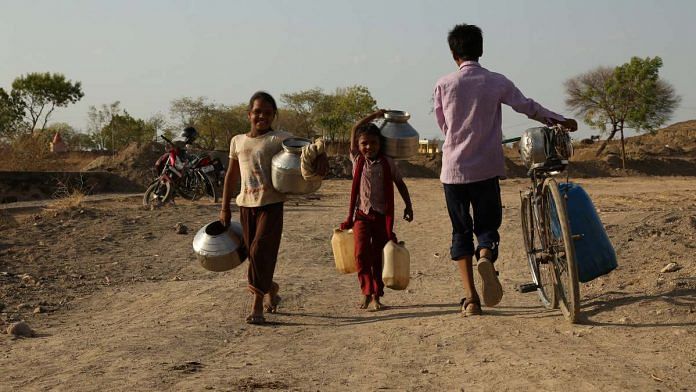What can I do? It’s my duty. I have to do it,” said a guard to a TV reporter helplessly, when asked what he was doing outside given the raging heatwave sweeping India. His job requires him to patrol a park, and he will have to do it through the unabating heat, he explained. All he had for protection were a pair of sunglasses and a long white cloth draped around his head.
His predicament is shared by millions of others in India, who don’t have the option to stay indoors, as doctors and government advisories have recommended.
Heatwaves are fast becoming a staple of Indian summers, and this particular one — which began in March, spread across the subcontinent, and went on till April — arrived earlier than usual, bringing with it temperatures that are otherwise typical of May. Respite will be short lived, the Indian Meteorological Department (IMD) said on Thursday, and another heatwave is likely to set in 7 May onwards.
The early heatwave’s arrival threw a spanner in the works of schools that were hoping to keep their doors open, two years after the pandemic forced them shut. Some schools are considering revising their timings, while others have decided to close early. The heat is projected to shrink crop yields, and is likely to make thousands of people who can’t avoid the heat ill with heat strokes. It has worsened an ongoing power crisis, and brought with it questions about the extent climate change influenced soaring temperatures in the subcontinent.
Indeed, experts have warned that India will face more frequent and intense heat waves in the coming decades, and if global warming doesn’t slow down considerably, they’ll only get worse.
It’s for all these reasons that the heatwave is ThePrint’s Newsmaker of the Week.
Also read: India’s heatwaves testing limits of human survival as climate becomes core threat to health
A spotlight on policy
In an article, the BBC describes in terrifying detail what happens to the body at extreme temperatures: At 40 degrees, heat exhaustion and fatigue are likely to set in. At 41 degrees of prolonged exposure, the body begins to shut down.
“Chemical processes start to be affected, the cells inside the body deteriorate and there is a risk of multiple organ failure. The body cannot even sweat at this point because blood flow to the skin stops, making it feel cold and clammy. Heatstroke — which can occur at any temperature over 40C — requires professional medical help and, if not treated immediately, chances of survival can be slim,” it says.
Anyone forced to work outdoors in the unrelenting heat would be able to tell you this. Heatwaves have already killed 24,380 people from 1991-2018, according to the National Disaster Management Authority (NDMA). The most vulnerable are the poor and elderly, for whom exposure can be lethal.
The fact of the heatwave’s early arrival, pushing temperatures across Delhi, Uttar Pradesh, Madhya Pradesh, Vidarbha, and Odisha as high as 43 degrees, has also called for renewed focus on government planning to mitigate its effects.
An editorial in the Hindustan Times calls for a “robust public health policy” including better early warning systems and community outreach. “As the climate crisis heightens extreme heat risks in India, authorities must work to further strengthen these plans and adapt them in consultation with local communities. After all, climate resilience is, in part, about asking people to think differently and see extreme heat and other climate challenges as solvable public health issues.”
India’s heat risk interventions are fairly new. Climate-related health risks were only added to its adaptation and mitigation efforts in 2015. That same year, the NDMA came out with its guidelines for states on how to adapt to heatwaves. The National Action Plan for Climate Change and Human Health — which seeks to reduce death and injury from climate-related extreme weather — was designed three years later, in 2018.
The implementation of these plans and guidelines can’t be enforced by the central government, and monitoring their progress can be tough, officials have said. Heatwave-prone states were also encouraged to design their own Heat Action Plans, but the initial findings of a study evaluating them, which is likely to come out later this year, said they lacked “focussed, hot-spot based interventions.”
Also read: Here’s what lies behind India’s rising heatwaves even before ‘hot season’ kicked in
A power crunch
Rising temperatures have also caused a mad rush for air conditioning — for those who can afford it — according to various AC companies, who say they have seen record sales this season. The need to stay cool has put pressure on India’s energy sector, further shrinking coal stockpiles and causing blackouts.
According to a survey, two out of three participating households faced power outages, while one out of three faced them for at least two hours at a stretch.
Experts have said the power crisis was made worse by lack of efficient demand forecasting and planning, but also that it highlights the need to diversify energy sources. Seventy per cent of India’s electricity requirements are currently met by coal.
“As many analysts have since pointed out, the situation cries out for more global investment in India to retire coal, buy out existing contracts, compensate affected communities and switch to renewables. After all, power crises hit India when temperatures are at their highest and the sun is shining,” economist Mihir Sharma wrote in a column.
The chairman of clean energy giant ReNew is more enthusiastic, saying the crisis is likely to facilitate India’s transition to renewable energy.
After all, India does have large shoes to fill, and fast. At the COP26, India pledged to meet 50 per cent of its energy requirements through renewable sources by 2030. It also promised – along with 197 other countries – to “phase down” coal, although with no set date in mind.
Views are personal.
(Edited by Prashant)



